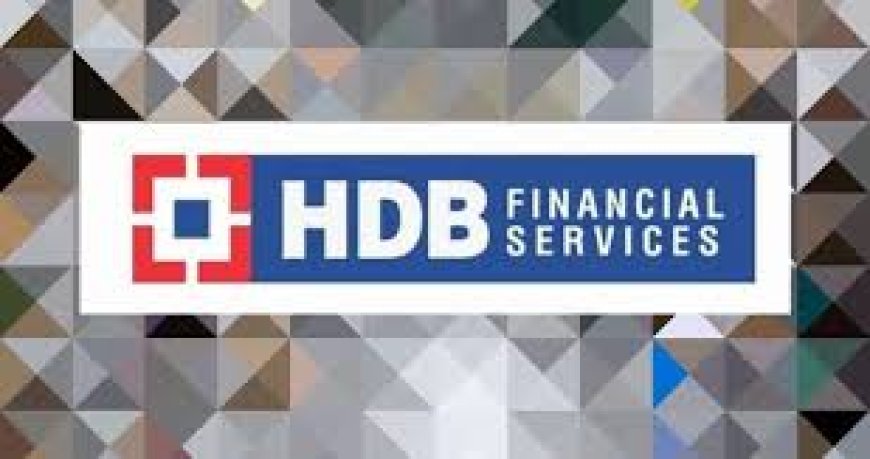HDB Financial IPO: Eight things to know about India's largest-ever NBFC IPO
Discover eight must-know facts about the upcoming HDB Financial IPO—India’s largest-ever NBFC listing. Includes financials, investor outlook, and strategic implications.

HDB Financial IPO: Eight Things to Know About India’s Largest-Ever NBFC IPO
In a development poised to reshape the Indian financial services landscape, HDB Financial Services Ltd., a subsidiary of HDFC Bank, has filed draft papers with the Securities and Exchange Board of India (SEBI) for what is set to be India's largest-ever non-banking financial company (NBFC) initial public offering (IPO).
The eagerly anticipated listing comes amid strong investor interest in financial sector stocks, especially those with backing from major banking institutions. Here are eight key takeaways that market participants, retail investors, and analysts are closely tracking.
1. IPO Size and Stake Sale
HDFC Bank plans to divest up to 19.00% stake in HDB Financial through the offer for sale (OFS) route. While the exact issue size will be finalized closer to the launch date, market estimates suggest the IPO could raise anywhere between ₹8,500 crore to ₹10,000 crore, making it the largest NBFC IPO in India’s history.
According to HDFC Bank’s FY24 annual report, HDB Financial is valued at approximately ₹60,000 crore. The proposed dilution is expected to help HDFC Bank meet regulatory norms and unlock value.
2. Parentage and Promoter Strength
HDB Financial is wholly owned by HDFC Bank, one of India’s largest and most trusted private sector banks. The parentage lends HDB significant strategic and operational advantages, from funding access to credit underwriting expertise.
"Backed by HDFC Bank, HDB Financial commands market trust, and its risk metrics are a direct reflection of the parent’s conservative lending ethos," says Siddharth Mehta, Financial Sector Analyst at ValueMatrix Securities.
3. Robust Financials and Diversified Portfolio
As of FY24, HDB Financial reported a net profit of ₹2,011 crore, up 44% year-on-year, with assets under management (AUM) of over ₹70,000 crore. Its lending portfolio is diversified across personal loans, gold loans, consumer durables, used car finance, and enterprise loans.
The company’s gross non-performing assets (GNPA) stood at 1.4%, with a net NPA of 0.5%—indicative of healthy asset quality in a rising interest rate environment.
4. IPO Timing and Market Conditions
The IPO comes at a time when the Indian stock market is scaling new highs, buoyed by strong macroeconomic indicators, political stability post-general elections, and healthy corporate earnings.
"A listing during a bullish market cycle augurs well for HDB. We expect significant institutional and retail participation," notes Priya Rathi, Fund Manager at SwanCap Investments.
5. Use of IPO Proceeds
Since the IPO is structured as an OFS, the entire proceeds will go to the selling shareholder, HDFC Bank. However, the listing will help HDB establish an independent market presence, create shareholder value, and pave the way for future fundraising.
Industry insiders speculate that the IPO may also help HDFC Bank boost its capital adequacy and strategically realign focus post its merger with HDFC Ltd.
6. Regulatory and Strategic Implications
The RBI mandates that banks must reduce their shareholding in non-core subsidiaries, especially NBFCs, to avoid conflicts of interest and systemic risk concentration. The IPO, therefore, aligns with regulatory expectations.
Additionally, analysts view the move as HDFC Bank’s strategic pivot to allow its subsidiaries to operate with greater autonomy, akin to ICICI Bank’s approach with ICICI Lombard and ICICI Prudential.
7. Peer Comparison and Valuation Metrics
At an indicative valuation of ₹60,000 crore, HDB Financial’s price-to-book (P/B) ratio is expected to hover around 3.2x, which is slightly premium to peers like Bajaj Finance but justified by its parentage and strong underwriting standards.
"Compared to other listed NBFCs, HDB’s portfolio shows a fine balance between growth and risk control. The valuation premium may hold as long as it sustains these metrics post-IPO," observes Rajiv Bansal, Director of Research at Apex Equities.
8. Investor Outlook and Risks
The IPO is likely to attract long-term investors looking for exposure to a high-quality NBFC with stable margins, diversified lending, and digital-first initiatives. However, some risks remain:
-
Dependency on HDFC Bank for funding and operations
-
Exposure to retail unsecured lending amid a rising interest rate environment
-
Competitive intensity from fintech and agile NBFCs
Still, with the government pushing for financial inclusion and robust consumption-led credit demand, the growth outlook for quality NBFCs remains bright.
A Milestone Moment for India’s Financial Sector
The HDB Financial IPO marks a watershed moment in India’s NBFC evolution. If successful, it not only strengthens HDFC Bank’s balance sheet but also boosts investor confidence in the broader NBFC ecosystem. Market watchers will keenly observe how the listing reshapes valuations and capital market appetite for large-scale financial service providers.
What's Your Reaction?
 Like
0
Like
0
 Dislike
0
Dislike
0
 Love
0
Love
0
 Funny
0
Funny
0
 Angry
0
Angry
0
 Sad
0
Sad
0
 Wow
0
Wow
0












































































